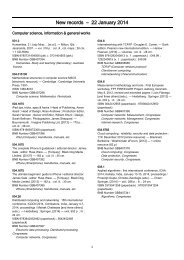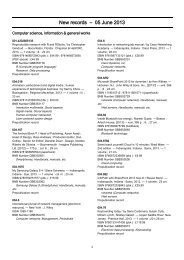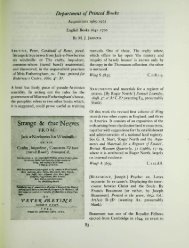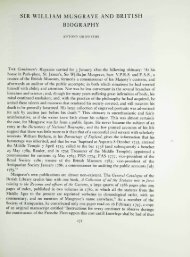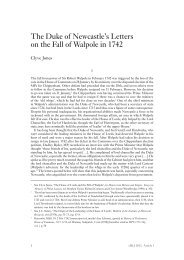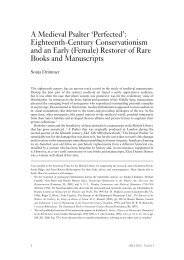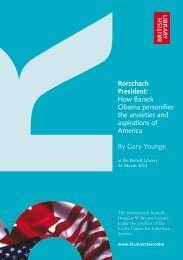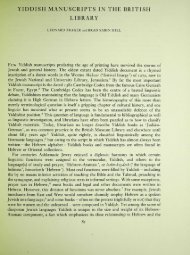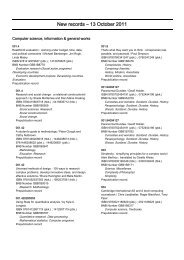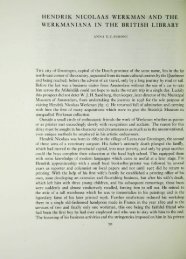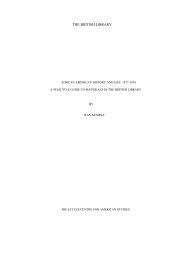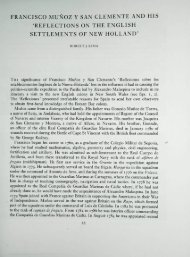TWO FRAGMENTS FROM COTTON MS. OTHO B. X - British Library
TWO FRAGMENTS FROM COTTON MS. OTHO B. X - British Library
TWO FRAGMENTS FROM COTTON MS. OTHO B. X - British Library
You also want an ePaper? Increase the reach of your titles
YUMPU automatically turns print PDFs into web optimized ePapers that Google loves.
SHORTER CONTRIBUTIONS<br />
<strong>TWO</strong> <strong>FRAGMENTS</strong> <strong>FROM</strong> <strong>COTTON</strong> <strong>MS</strong>. <strong>OTHO</strong> B. X<br />
IN his Catalogue of Manuscripts containing<br />
Anglo-Saxon,^ N. R. Ker notes for <strong>British</strong><br />
<strong>Library</strong>, Cotton <strong>MS</strong>. Otho B. X^ (his no. 177^)<br />
that ff. 52 and 54 can not be identified. Any<br />
subsequent work by other scholars involving<br />
the use of this manuscript has also failed to<br />
identify these two folios and their contents<br />
have remained a mystery.<br />
That they have presented a problem is<br />
perfectly understandable. The manuscript has<br />
suffered tbe most unfortunate of histories. It<br />
was almost destroyed in the fire of 1731^<br />
subsequently being bound in the wrong order,<br />
with some leaves reversed or even upside down<br />
and others alien to the manuscript as a whole.<br />
In reassembling tbe texts the palaeographer is<br />
indebted to the work of Humphrey Wanley and<br />
his Catalogus,^ which lists the original contents<br />
in their correct order.<br />
Cotton Otho, in its present day condition,<br />
contains sixty-seven card-bound leaves. Of<br />
these ff. 6 and 50 are really one, as are ff. 34<br />
and 35, bringing the total down to sixty-five.<br />
However, f. 67 is in fact two separate leaves<br />
wrongly placed together bringing the sum of<br />
the leaves back up to sixty-six. Several leaves<br />
from outside are alien to the manuscript, namely<br />
ff- 29, 30, 51, 55, 58, 61, 62, 63, 64, 66,-^<br />
numbering ten in all. If tbese are removed from<br />
Cotton Otho then the resulting sum of extant<br />
leaves is fifty-six. Taking the best preserved<br />
leaves as a guide, the original size of each page<br />
could be estimated as c. 195 x 150 mm., with<br />
written space measuring c. 175 x 115 mm.<br />
S. D. Lee<br />
The pages are numbered in lead on the top<br />
rigbt of the recto of the card surround. It was<br />
foliated presumably at the same time as the<br />
modern headings were added. Titles are<br />
written in red, and dabbing in the same colour<br />
occurs on the first letter of the sentence and<br />
most Tironian signs.<br />
As with so much of the manuscript as a<br />
whole, the two leaves in question are very badly<br />
damaged and contain only a fragment of each<br />
original folio. However, with successive readings<br />
under the ultra-violet lamp at the <strong>British</strong><br />
<strong>Library</strong> over several weeks, these two fragments<br />
can now be identified as containing parts<br />
of tbe lives of St Sebastian^ St Eufrosma^ and<br />
St Eugenia^ from the Lives of Saints^ partly<br />
written by ^lfric.<br />
At its maximum f. 52 measures c. 60x95<br />
mm., whilst f. 54 reaches c. 55 x no mm. As<br />
with all the leaves of the manuscript they are<br />
bound in card surrounds, show bad signs of<br />
burn damage, are much shrunken, and have<br />
numerous holes and taping all over tbeir<br />
surface. However, under the ultra-violet lamp<br />
the following letters could be discerned i*'<br />
F.<br />
fram<br />
acwea Heo weard<br />
hib .]?aw<br />
nysse set byrge<br />
licere g<br />
beofo .M
meh<br />
blysse 7m<br />
d<br />
on<br />
F. 52V<br />
geseab<br />
he s lfa ferde geond maniga e wenunga<br />
hwilcne godes man findan<br />
ge nnion mibte. j'a x<br />
e |^3ES minstres ae wa;s swij^e m^re be<br />
7 I'a m )'xr in gesealde<br />
I'eodrae to6am ab ude 7 to ]'am<br />
ter mi j^am<br />
ge<br />
dam<br />
gel<br />
bastianus c<br />
eas ydclnes swa<br />
te. Manega men adrin<br />
e. 5eonmisl ti<br />
de comon. Oft on a<br />
for wel mscnige de<br />
ngle on £er ed<br />
leo<br />
I'on<br />
sum<br />
F. S4V<br />
lcna<br />
se 06<br />
leas<br />
him<br />
].>aes<br />
wurde godes wil<br />
gen beg irdon. hi<br />
a hund. micclutn<br />
a us haefde b his di<br />
Care was taken when examining these<br />
fragments to complete transcription before<br />
checking them against any possible correlating<br />
text, in case sections from the already edited<br />
text might suggest their own presence on the<br />
page.<br />
The method of identification was straightforward.<br />
It was clear that f. 52V contained the<br />
most complete text and was therefore chosen as<br />
a starting point. Several words deemed to be<br />
the least used throughout the corpus were<br />
noted and checked against the Toronto Microfiche.^<br />
This invaluable tool has the advantage<br />
of giving the location of words in context.<br />
Consequently, the passage could be identified<br />
as belonging to the life of St Eufrosina, and<br />
corresponding to 11. 10-19 of Skeat's edition^<br />
(II, pp. 334-6). As this was at the beginning of<br />
the text, it followed that f 52r might contain<br />
material from the preceding saint's life.<br />
Wanley's catalogue revealed this to be St<br />
Eugenia., and the transcription was found to<br />
correspond to 11. 413-24 of Skeat's edition (I,<br />
pp. 48-50).<br />
Folio 54 proved more troublesome, for the<br />
leaf is in a marginally worse condition than f<br />
52. However, on the third reading the partial<br />
form 'bastianus' was identified on the fourth<br />
line of the recto. As the manuscript was known<br />
to have originally had a version of the life of St<br />
Sebastian it was evident that, at the very least,<br />
the recto off 54 contained some material from<br />
that text. Subsequent research revealed it to<br />
correspond to 11. 270—8 of Skeat's edition (I, p.<br />
134). However, the material found on the verso<br />
corresponds to that of Skeat's II. 242-50,<br />
showing that the leaf was unfortunately reversed<br />
when bound in card.<br />
Furthermore, Ker notes that ff. 2 and 8 of<br />
Cotton Otho also contained some parts of St<br />
Sebastian, and f 13 could be identified as<br />
containing the title of St Eufrosina. Examination<br />
of f 8 revealed that it contained the<br />
beginning of tbe life 0^ St Agnes and 11. 469-74<br />
of St Sebastian, and was not therefore closely<br />
connected with f 54. However f 2r contains c.<br />
11. 280-94 of St Sebastian and f. 2v c. 11.
254-65. This discovery implies two things; formed the lower section of the original leaf<br />
first, that the leaf was mistakenly reversed and f. 13 the upper. Using this new inwhen<br />
bound, and, second, that f 54 and f 2 formation, the figure fifty-six for the extant<br />
were originally the same leaf" leaves given earHer found in Cotton Otho<br />
Similarly, f. 13 was found to be reversed and should now be modified to fifty-four,<br />
also to have been originally part of the same Finally, the following passages give the<br />
leaf as f 52. Folio 13V contains 11. 393-412 of relevant passages in Skeat with the letters<br />
St Eugenia and f. i3r contains 11. 1-9 of St corresponding to those of the two new frag-<br />
£«/ro5/M£J, both of which immediately preceded ments underlined. In the footnotes I identify<br />
the text contained on f. 52rv. Thus, f. 52 the new spelling variants.'^<br />
F.<br />
asend fram J^am casere.and he fx.t m^den acwealde.<br />
Heo weard ]^a gemartyrod. and cristene menn hi bebyrgdon.^^<br />
Da weop seo modor.mid mycelre sarnysse.<br />
^ hyre byrgene.o)^ yxt heo hi geseah.<br />
on gastlicre^^ gesihde.mid golde gefreetwode<br />
mid dam heofonlicum werode.)>us hi' frefigende.<br />
Mm modor claudia.me hgfd gebroht<br />
min haelend crist to his haigena blysse.<br />
7 minne faeder gelogode on J^aere heah-fkdera getele.<br />
and y>u cymst to lis.nii on sunnan-daeg.<br />
Seo modor gewat 6a of worulde to heofonum<br />
on'^ dam sunnan-d^Ege. and |^a suna hi be-stodon.<br />
{Life ofSt Eugenia, 11. 413-24; I> PP-<br />
F. 52V<br />
geseah hire weres sarignysse. and he sylf^^ eac ferde geond manige^'<br />
stowa.gif he weninga^^ hwilcne godes man findan mihte )'aet his<br />
gewilnunga gefultumian'^ mihte. L'a aet nyhstan becom he to sumum<br />
mynstre. y^fES mynstres faeder wass swyde maere beforan gode. and<br />
]>z micelne dael feos )nder''^^ in-gesealde. and miccle ^eodraedene<br />
] g ^<br />
nam to Vam abbode.^'^ and to V>am gebrodran. and ]^a aefter micelre<br />
tide cydde he V'am abbode his gewilnunge. se abbod J^a him efnsargode.<br />
and bsed god geornlice J^aEt he ]>zm ]?egne forgeafe bearnes<br />
wxstm. )^a gehyrde^^ god heora begra bene.and forgeaf him ane<br />
dobtor.Mid y-y pafnuntius geseah p^s abbodes mxran drohtnunge.<br />
(Life of St Eufrosina, II. 10-19; H^ PP-<br />
F- 54*-<br />
to gearlicum tidum . and tunglena ymbrynum.<br />
Policarpus saede pis we for-seod.<br />
85
on ]?am is sodfest-nysse gelicnys . ac hit is leas swa J^eah.<br />
Sebastianus cwxp^^ . ]?is is swutol ge-dwyld.<br />
and leas ydelnyss^^ . swa swa we ieornodon act criste.<br />
Manega menn'^"^ adrincad . on anum dxge togaedere.<br />
t>e on mislicum tidum to middan-earde comon.<br />
Oft on anum gefeohte feallad for wel<br />
under anum tungle . nxron^^ asr akennede.<br />
{Life of St Sebastian^ \\. 270-8; I, p.<br />
F- 54V<br />
t>a l^e habbad geleafan . and Ieornodon to campienne.<br />
ongean Vone swicolan feond . unforhte ]?urh god.<br />
and habbad cristes byrnan . hi magon to-brecan da godas.<br />
Chromatius da cwted . to f^am cenum godes pegnum.<br />
gewurde godes willa and eower eac aet ]?ysum.<br />
Hi J>a sona begen be-gyrndon^^ hi" cafiice.<br />
and to gode gebaedon . and to-braecon da anlicnyssa<br />
ma l^one twa hund . micclum gode f^anciende.<br />
Chromatius haefde behydd . on his digolnysse.<br />
{Life of St Sebastian., 11. 242-50; I, p.<br />
1 (Oxford, 1957), pp. 224-9.<br />
Finally, f 66 is in fact part of the eleventh<br />
2 Hereafter 'Cotton Otho'.<br />
century Life of St Machutus and belongs in<br />
3 See also nos, 168, 175, 178-81 for other parts of Cotton Otho A. VIII.<br />
the manuscript.<br />
6 Due to the nature of these fragments, there is no<br />
4 An earlier description of the original contents of attempt to show the numbers of missing or<br />
the manuscript can he found in Thomas Smith's illegible letters in the gaps.<br />
Calalogus Librorum Manuscriptorum Bibliothecie 7 For this, and indeed all the transcriptions, the<br />
Cottonice (Oxford, 1696), p. 70. There are spacing as printed in this article should not be<br />
discrepancies between his and Wanley's table of viewed as being to scale.<br />
contents, but the latter provides a fuller de- 8 A. Dipaolo Healey and R. L. Venezky (eds.), A<br />
scription, giving the beginning and the end few Microfiche Concordance to Old English (Uni-<br />
words of each section.<br />
versity of Toronto), for which the letters C and D<br />
5 Ff 29 and 30 contain ^Elfric's homily on the have now been edited.<br />
Book of Judith which can be assumed to he alien 9 W. W. Skeat (ed.), Mfnc's Lives of Saints,<br />
to the original manuscript as they are the only E.E.T.S. (London, 1881, 1900), 2 vols.<br />
two folios to have glosses in the 'tremulous 10 I.e., 11. 270-8 found on f. 54r lie between those<br />
hand'. F. 51, part of the West Saxon gospels, is found on both sides off 2. The text should thus<br />
from the early to middle part of the eleventh read f 54V, f 2v, f 54r, and f. 2r. F. 54 originally<br />
century. Its correct placing is as f 8 in BL, formed the upper half of f 2.<br />
Cotton <strong>MS</strong>. Otho C. I. Ff 55, 58 and 62 are of<br />
the mid-tenth century and are in fact from<br />
11 I have used Skeat's manuscript sigla throughout<br />
the following passages. The notation is as<br />
Bede's Historia ecclesiasttca gent is anglorum.<br />
Cotton <strong>MS</strong>. Otho B. XI. Ff 61, 63 and 64 are<br />
from the late tenth to the early eleventh century,<br />
containing part of Alfred's Pastoral Care. They<br />
should be placed after f 51 of Cotton Otho B. II.<br />
follows: J = BL, Cotton <strong>MS</strong>. Julius E. VII, O<br />
- Cotton <strong>MS</strong>. Otho B. X, and V = Cotton <strong>MS</strong>.<br />
Vitellius D. XVII. For all four excerpts, Skeat<br />
was obviously not aware of the contents of the<br />
two relevant leaves in O, and the footnotes I give<br />
86
are thus meant to supplement his own. It should<br />
be noted that variations between ']?' and '6',<br />
and *y' and 'i' have not been noted.<br />
12 O does not appear to have enough space to fit in<br />
the whole of * hehyrgdon' unless abbreviations<br />
were used.<br />
13 Skeat has 'gastlicre'; O has 'licere*.<br />
14 It is possible that the visible letters 'on' in O<br />
may, in fact, be from 'heofonum'.<br />
15 The section in Skeat is based solely on the<br />
readings from J.<br />
16 O has the ending 'lfa' which one assumes was<br />
originally 'sylfa'.<br />
17 O has 'maniga'.<br />
18 O has 'wenunga'.<br />
19 O has 'nnion'. In the gap between the 'ge' and<br />
the ending 'nnion' the ascender of the T is<br />
clearly visible.<br />
20 O has a Tironian sign before '|^a'.<br />
21 O omits 'has l*aer' instead of'>'ider'.<br />
22 O has the ending 'ude'.<br />
23 At some point here (the exact place is impossible<br />
to gauge) O has an additional '6am'. As it is<br />
clearly on a separate line to the visible 'ge', its<br />
possible correspondence with 'he dam J^egne'<br />
has been discounted as it appears too soon in the<br />
spacing of the text.<br />
24 The relevant section in Skeat is based entirely on<br />
readings from J.<br />
25 Possible abbreviation above 'c' indicating<br />
'cwaej^' in O.<br />
26 O has 'ydelnes'.<br />
27 O has 'men'.<br />
28 O has 'msenige'.<br />
29 O has 'on[]^r'.<br />
30 The relevant section in Skeat uses readings from<br />
both J and V.<br />
31 O has 'beg irdon' with a possible abbreviation,<br />
but more above the 'r' than centred over the 'i',<br />
indicating the insertion of an 'n'.<br />
32 The relevant section in Skeat is based on<br />
readings from both J and V.<br />
^IMPORTUNATE CRIES OF MISERY': THE CORRESPONDENCE<br />
OF LUCIUS HENRY HIBBINS AND THE DUKE OF<br />
NEWCASTLE, 1741-58<br />
DEEP in the papers of the Duke of Newcastle,<br />
the Whig 'ecclesiastical minister', lie the thirty<br />
or so letters written by tbe Rev. Dr Lucius<br />
Henry Hibbins^ to the Duke from 1741<br />
onwards. It is a remarkable collection, spanning<br />
eighteen years, and one overlooked by historians<br />
who have considered Newcastle's exercise<br />
of Churcb patronage. Mary Bateson<br />
ignores the correspondence, even though her<br />
aim was to exemplify the Duke of Newcastle's<br />
dealing with place-seeking clergy. More curiously<br />
Norman Sykes also ignores the collection<br />
and Daniel Hirschberg dismisses it in passing."<br />
The omission is significant since, among other<br />
things, the correspondence indicates that the<br />
censorious attitude of historians to placeseeking<br />
and self-reeommendation for preferment<br />
should be reconsidered. Hibbins's<br />
William T. Gibson<br />
appeals for a place represent the claims of a<br />
clergyman who had worked for the Church<br />
through a political 'interest', which he felt had<br />
then deserted him.<br />
The first surviving letter from Lucius Henry<br />
Hibbins to the Duke of Newcastle is dated 9<br />
January 1741, though it is clearly not their first<br />
communication. The letter, written from<br />
Norton near Chichester, one of the Duke's<br />
Sussex boroughs, indicates tbat Hibbins bad<br />
already petitioned the Duke for a living but had<br />
been disappointed. Hibbins had organized and<br />
presented a petition from some residents of<br />
Chichester promising to vote for the Duke's<br />
candidates in the coming elections. Hibbins<br />
also indicated to Newcastle that the Dukes of<br />
Aneaster and Richmond were well-disposed<br />
towards him; this was a customary way of



